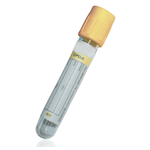Suitable Specimen Types
- Serum
Sample Processing in Laboratory
Usual
Sample Preparation
Centrifuge.
Do not analyse grossly haemolysed or grossly lipaemic samples.
Turnaround Time
3-5 daysSample Stability
Serum or heparinised plasma samples are required, gel tubes are preferred.
Specimens should be tested within 8 hours of collection if kept at room temperature. Specimens can be stored at 4º C for up to 2 days, for longer periods store frozen at -20ºC.
Valproate
General Information
Valproate (valproic acid) is primarily used in the treatment of petit mal seizures and other generalised and partial complex seizures. Due to the potential of severe adverse reactions it is important that serum levels of valproate be monitored during therapy.
Valproic acid is a drug that is used mainly to treat certain fitting disorders (also called seizures or epilepsy), but is also prescribed to treat bipolar disease (manic depression) and to prevent migraine headaches, though this is an unlicensed use of valproic acid in the UK. It may be used in combination with other antiepileptic drugs such as phenytoin or carbamazepine to control certain kinds of seizures.
The levels in serum do not correlate well with therapeutic/toxic effects and it is generally agreed that monitoring valproate levels is not useful.
Adverse reactions to valproate therapy include liver dysfunction, nausea, vomiting, sedation, stupor and in some cases patients may develop psychiatric symptoms.
Patient Preparation
Samples should be taken at trough drug levels by collecting a sample prior to the next dose.
Notes
Grossly haemolysed or grossly lipaemic samples, or samples with a bilirubin concentration >650 µmol/L should not be analysed.
Reference Range
There is no recommended therapeutic range for valproate
Source : Pathology Harmony Recommendations
The levels in serum do not correlate well with therapeutic/toxic effects and it is generally agreed that monitoring valproate levels is not useful.
Specifications
- EQA Scheme?: Yes
-
EQA Status:
Heath Control TDM EQA scheme
